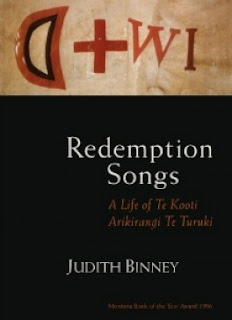Steve Braunias recently sent me and a bunch of other New Zealand scribblers a list of the hundreds of titles that have won national book awards over the past fifty years. He asked each of us a to choose a top twenty from the list, and then compiled our choices into a top fifty for the The Spinoff Review of Books. This is the list I sent to Braunias.
Judith Binney, Redemption Songs (1996)
Our Homeric epic. Binney's life of Te Kooti is inexhaustible, and turns its protagonist into a figure as wily and unkillable as Ulysses.
Michael King, Moriori: a people rediscovered (1990)
Not many books have helped rescue a people from oblivion: this one did.
Anne Salmond, Trial of the Cannibal Dog (2004)
Salmond's years of research on Polynesian outliers, where the sound of the sea is constant and the rest of the world consists of a series of visiting ships, gives her account of Cook's voyages and landfalls a veracity that no library-bound scholar could achieve.
Michael Jackson, Pieces of Music (1995)
Jackson is a forgotten man in New Zealand, but an honoured scholar and writer overseas. This series of prose poems shows a young man with a head full of Camus and Apollinaire floating through postwar New Zealand.
MK Joseph, The Time of Achamoth (1978)
Time travel stations hidden in the King Country, visits to the Paris Commune and a future dystopia, a fight with a monster living in Karl Marx's grave: what more can a novel offer? The Time of Achamoth is a neglected masterpiece.
CK Stead, Smith's Dream (1972)
A rewrite of Mulgan's Man Alone by a young man obsessed with apocalypse. Smith's Dream has haunted Stead: he wrote it quickly, so quickly he might have been taking dictation, and he knows that the painstaking and overstuffed novels he has created in recent decades have lacked the power and precision of his debut.
Nga Iwi o Tainui, ed. Rei Te Hurihuri Jones and Bruce Biggs (1989)
An extraordinary arsenal of images and symbols and stories, wrought from the oral tradition of a great and greatly
wronged iwi.
Michael King, Te Puea (1978)
A book that introduced the Pakeha world to the monarchy on their doorstep and the Maori civil rights movements of the twentieth century.
Martin Edmond, The Autobiography of My Father (1990)
Edmond reinvented creative non-fiction with a magnificent sequence of books in the '90s and early 2000s. This isn't his best book - he was still learning how to link anecdote to anecdote, still apologising for the dreams and hallucinations he would later treat as revelations - but it'll do.
Douglas Wright, Ghost Dance (2008)
Wright's prose is so exact and sensual that he manages to make the ugliness of his illness strangely erotic.
Dick Scott, Seven Lives on Salt River (1989)
A regionalist masterpiece, and a rebuke to urbanites who disregard the history of places like the Kaipara.
Albert Wendt, Leaves of the Banyan Tree (1980)
A huge book that shows Wendt's extraordinary ambition and energy.
Kendrick Smithyman, Stories About Wooden Keyboards (1985)
The sly old fox of New Zealand verse. I published a book about him; of course I'm going to nominate him.
Judith Binney and Gillian Chaplin, Nga Morehu (1987)
Judith Binney made oral history respectable again in the academy, after long decades when it was shunned. The ghost of James Cowan must have been happy.
Frank McKay, The Life of James K Baxter (1991)
McKay's conservatism and tepid tone makes his account of a hellraiser's life unintentional funny. When he deals with the Baxter crew's orgies and drug-taking McKay resembles a Presbyterian vicar tiptoeing past a brothel.
Janet Charman, Cold Snack (2008)
Charman is a schoolteacher from Avondale. She writes what she sees in tight, truncated lines that build steadily in intensity.
Allen Curnow, An Incorrigible Music (1980)
Curnow may have resembled a pipe-smoking, cardigan-wearing professor, and the academic industry may be doing its best to make him safe and presentable, but make no mistake: he was a dark magus. Curnow's death-obsessed imagination finds its perfect subject in 'Moro Assassinato', a long, bloodthirsty, brilliant poem that begins in the waves of Karekare and moves to Italy, where the Red Brigades kidnap and slay the country's top politician.
Tony Simpson, The Sugarbag Years (1974)
By the seventies, Depression-era New Zealand seemed like a lost civilisation, a brutal and impoverished place that had been determinedly forgotten. Simpson explored the ruins of remote work camps, and excavated stories of suffering and rebellion from old men and women.
Michelle Leggott, Dia (1994)
Leggott's book upset all the right reviewers, who complained they couldn't understand her poems. As Wallace Stevens said, though, great poetry communicates before it is understood.
Sam Sampson, Everything Talks (2009)
Sampson is an unrepentant avant-gardist, a spinner of Joycean word games, an enemy of linear thought and full stops. He remains holed up in the Waitakeres, where he takes inspiration from the rune-like patterns flying ducks and kereru make on the evening sky.













